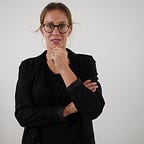Design Skills to Practice to Prepare for Complexity — Meet Dinara
If you are stepping into a management room or management school today, design is most likely a natural part of the curriculum. For the last 5 years, we have seen an increase in design mixed roles such as service designers, business designers, organizational designers, design technologists, and similar. Part of this is driven by the design demand on the market and part of it by the complexity that organizations are facing. Dinara is an educated business designer with research and design skills. With a background in business rather than design, she shares her perspective on how you as a manager or lead can use design skills to make your work more valuable.
Wait with structure
Creatives, whether you are a chef, architect, or product designer, spring from similar drivers. They are driven by inquiry and curiosity to find insights and create something. These drivers are at the core of their approach, and rules or regulations will not stand in the way. They are accustomed to working in a chaotic environment where testing and shaping are the way to find a new solution, leaving boundaries open as long as possible. This is how creatives learn and develop their skill.
“Creatives are driven by inquiry and curiosity to find insights and create something.”
In contrast, people with more non-creative backgrounds are schooled and driven by adding structure as early as possible in the process. The focus lands on how and when, and sometimes at the cost of answering why and what. Most times they are taught to solve a problem, not to ask if it is the right problem to solve.
“Asking why and what will help you to open up your ideas. Whereas asking how and when means that you have closed the room for what the idea is”
So if you want to prepare your team for using more design-driven approaches, you should train them to start by asking and answering the why and the what. As well as avoiding following rules and regulations at the start. In your role as team lead or manager, you can help them by keeping things open and avoid adding structure early in the process as it will become a hinder in the process of solving the right things.
To consider: What are you asking your team to answer, why, what, how, or when?
Aim for impact
In addition to work, responsibilities, timelines etc, designers also need to take into consideration having time for not only questioning the why but also designing the what. Dinara believes that striving for high impact is the key to the design role and she reaches that by taking a holistic approach to the things you have to do and deciding how resources are spent.
“By using your time and resources wisely you can reach impact early”
“There are some fairly easy tricks to get there just by choosing how your team spends their time”, Dinara says. Teams shall spend time on aligning and evaluating work. Building relationships and aligning. They also need room for flow to do creative work and to make ideas become concrete and bring them to life.
“Way too much time is spent in meetings, and in addition to that, I have seen many teams trying to do all their creative work together.”
Aim to use the time together in meetings to align and take decisions. Whereas creative time needs to happen in other formats. People reach flow in different ways and need creative room for both individual and teamwork, especially outside of meetings.
Dinara believes that through aiming for high impact things become concrete and you get tangible output which as a next step enables the teams to build better relationships and align with stakeholders internally. “With concrete output and good relationships, you can have a higher impact and create better products and services”, says Dinara.
To consider: What is your team spending their time on?
Frame things
The third skill that requires some practice but is an important part of the designer’s role, is the ability to frame things in a complex environment. As the world becomes less predictable and changes happen faster work, operations, projects, scope, products, road map, and businesses need to be designed with more complexity in mind.
“Framing is about finding what questions to ask, what expected goals and results there are and who shall be involved with the work.”
Though a big degree of success in larger companies lies in managing expectations and outcomes of investments. You want to make sure you get the right people on board and align with them. In addition to that, knowing that you are solving the right things.
The intent of framing is to increase the success rate of getting a service or product through the organization. The result is that you’ll have more people from different departments involved and engaged. Whilst still being able to progress with the work.
“By framing work teams start working and therefore make progress earlier, even though it is a complex environment.”
If you want your team to develop more design skills, use the approaches above in your way of working, and you shall expect to get more value and more quality from your work.
To consider: What do you do today to ensure to align on expectations throughout the company?
________________________________________________________
About Dinara
Where does she live? In Gothenburg, Sweden
What does she like to do during “non-working” time? Cooking, reading, taking pictures
What is she passionate about? Art in all forms, especially art that brings something painful/unjust to light
______________________________________________________________
Interested in understanding how you can help your team to skill up?
Or how to evolve your design skills in the team? Or in what way research and business can help your team?
Reach out and we’ll help you to figure out your next step
anna@topp.se & dinara@topp.se
